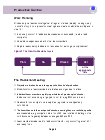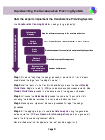Collaborative planning: a guide for Highways England supply chain
In this guide we outline Highways England’s approach to the Collaborative Planning System; a technique based on lean methodologies.
Use this guide if you are a member of the highways industry, have a basic understanding of Lean principles and want to implement Collaborative Planning in your own organisation.
In Highways England we use Lean principles to support our 3 imperatives:
- safety – ensuring no one is harmed when travelling or working on our roads
- customer service – improving what we do and how what we do it to reduce the impact of our work on road users
- delivering the Road Investment Strategy – on time and efficiently
About Collaborative Planning
Collaborative planning is much more than planners talking to sub-contractors to develop the contract programme. Collaborative planning is about contractors and sub-contractors working together to improve productivity, and reduce time and cost.
Collaborative planning has been used in construction for nearly 20 years and the productivity improvements achieved to date are well documented. The Lean Construction Institute outlines the challenges faced by the construction industry and the benefits of Lean principles.
The Collaborative Planning System is founded on the belief that to achieve the high level targets the team must achieve high reliability on daily / weekly tasks. The Collaborative Planning System consists of a series of tools, approaches and processes to:
- deliver better value to the customer to increase satisfaction
- remove waste from work processes to reduce time and cost
It enables teams to deliver the same amount of work but with less resource through:
- production control - better productivity through effective resource and information management
- collaborative mapping - better planning through the creation of process-based look-ahead programmes
- process improvement through the implementation and adoption of continuous improvement tools
The Collaborative Planning System should be viewed as an enabler to achieving the aspirations of a robust contract programme - not as the means to replacing it.
While Collaborative Planning System can be used on its own, the benefits it delivers can be enhanced by using it with Lean Visual Management.
The Collaborative Planning System is about planning to do work. Lean Visual Management is about putting people to work.
Production Control and Stand-up Meetings work together to set clear production targets and work assignments which can be done.
Process Improvement and Performance Improvement are two varieties of continuous improvement.
Collaborative Planning System and Lean Visual Management together provide teams with a set of tools with which to add value and reduce waste.
Before you start
It is worth remembering that people normally have a healthy scepticism about new ideas. They want to be sure that those ideas are sound before committing to change. Engagement, education and training are important to successful implementation.
With the Collaborative Planning System, teams working together to achieve clear shared goals. The Collaborative Planning System works best when:
- a collaborative form of contract exists that promotes improvement
- project leadership encourages and demonstrates working together
- project incentives are focused on improving the overall outcome
- project goals and the criteria for success are clearly defined
- a lean practitioner facilitates improvement
- all stakeholders contribute and are engaged in participation
- teams are willing to positively embrace transparency
- teams are prepared to be constructively honest yet direct with each other
- there is a commitment by all to jump in and learn by participation
- a designated area is available to facilitate teams coming together
- good facilitation skills are available to keep meetings concise and focused
Production Control
For a project to succeed, many things (information, labour, materials etc) need to arrive at the right place at the right time and in the right sequence.
Production Control is the means by which we manage these inputs, controls and resources to achieve efficient delivery.
The Production Control toolkit consists of:
- Work Planning - Get the team to meet regularly to create Work Plans, by using the Plan-Do-Check-Act cycle, and focus on making and keeping reliable promises - say what we do, do what we say - measuring and learning as they go
- Make Ready - Encourages the team to understand and remove the blockers stopping them from doing work before starting the task at hand
- Standard Processes - develop and re-use standard ways of doing repetitive tasks. The way teams do tasks often repeats but the volume of work in execution might change
- Data Analysis - Uses measurement and learning to inform the areas to improve performance and do process improvement
Collaborative Mapping
Collaborative mapping creates an environment and framework where team members from different companies and/or disciplines can
- work together for the good of the project
- create medium to long term forward looks
- understand each other’s’ constraints and drivers
- build and foster team spirit and collaborative behaviour
- collaborate and negotiate with each other in a proactive and productive way
Collaborative mapping can be used at a strategic level (whole programme), and at a tactical level (phase, area, next milestone, next 12 weeks, next 6 weeks).
How it works
Everybody involved in controlling the actual work or has a stake in success of the work attends a Collaborative Mapping Session to create a look-ahead plan as an integrated team.
This will ensure that everyone understands who does what and make plain any mutual dependencies and interactions. It allows commitments to be made as a team and develops trust and transparency.
Important stakeholders are introduced and can begin to engage right from the start, developing interpersonal relationships and a collaborative working environment. This allows:
- early programme buy-in and agreement of project milestones
- the early identification of interdependencies and sequencing issues
- the early clarification of front-end requirements
- the early identification of programme-related risks and opportunities
- the early promotion of two-way responsibility and accountability
Ultimately, the process will:
- reduce programme duration
- improve collaboration, transparency and understanding
- better integrate suppliers
- reduce time and cost
- allow side agreements to be clearly understood and captured
By focusing the team on a target, and asking them to collaborate in a proactive way to achieve it, time can generally be removed from planned activity durations.
How to run a collaborative planning session
To create the right environment the session should:
- be facilitated by somebody experienced and largely neutral who can foster an open, relaxed environment
- begin with group creation of robust ground rules designed to get the best out of everybody at the session
- be carried out in a large room provided with blank wall space, paper, Post-it notes and room to move around
- have refreshments at hand
During the session the facilitator should:
- keep introductions to a minimum
- focus on putting the team to work as quickly as possible
- be clear as to the purpose of the session: to leave the room with an agreed sequence of works that has team buy-in and understand any enablers / constraints needed to ensure success
- initially focus on the target for the team and clearly describe what this looks like so everyone is clear - ideally select an interim milestone or handover to focus the team’s efforts
- work backwards from the milestone and insert a colour coded Post-it note, by discipline / team member for each step
- capture constraints / enablers on the map, or separate list, so that all team members are clear and aligned
It is important to allow facilitated debate and negotiation within the session to get consensus on the process steps - the team should leave the room feeling engaged in the process and session, not feeling bullied into agreeing something.
Key output includes:
- a clear map of integrated colour coded steps
- timescales clearly understood and captured
- constraints and enablers clearly understood and captured
Next steps
After the meeting:
- agree how the team are going to control against their agreed progress and commitments - run production control sessions
- agree follow up sessions, timed to suit elements of work, or simply on a rolling programme of between 4 and 10 weeks depending on the type and size of the work
Process Improvement
Process improvement involves improving existing processes so that they are able to meet new goals, objectives or targets.
Process improvement is different to other continuous improvement techniques in that it is based on real problems backed up by real data. The majority of improvement action is generated and implemented by those doing the work, as opposed to senior management intervention.
Data drives improvement. The first step in implementing any Process Improvement is the collection of data, or where no data exists, the creation of data through measurement. Initial data sources will include:
- reasons for non-completion
- planned percentage complete
- key performance indicators
- other performance measures
Once you have established a robust set of data you can use this to identify problems and the associated baseline for improvement.
Generally teams will focus first on the “reason for non-completion” that has the highest score.
Following identification of the area for improvement, the team then defines the required outcome for the improvement, ie what is the team trying to achieve? Is it a percentage increase in a particular performance measure? Or a performance increase against a particular Key Performance Indicator?
The team then works together to determine a suitable solution using the Lean tools and techniques at their disposal. Once they agree a solution it should be implemented, controlled (through monitoring) and, where successful, transferred to others.
There are a number of different tools and techniques available that can be used to help deliver Process Improvement.
Blitzes
Blitzes are one of the most straightforward process improvement techniques. Generally, a Blitz is a one-off brainstorming event, conducted over a short period of time. It involves the people who actually do the work and focuses on productivity improvement and the identification of long term waste reduction. The outcome of a Blitz is implemented immediately to enable immediate step improvement in performance.
DMAICT
DMAICT is an acronym that stands for Define, Measure, Analyse, Improve, Control and Transfer. It is a structured lean sigma approach that helps teams to:
- define a recognised problem or opportunity
- measure the current process and performance
- analyse the data to identify improvement opportunity
- determine the optimal solution for improvement and implement
- maintain and control associated improvements
- transfer those improvements to other areas of their business





